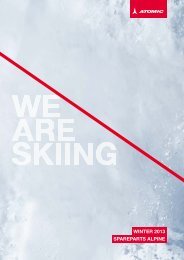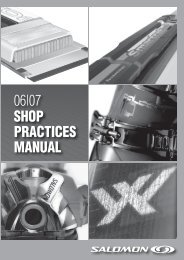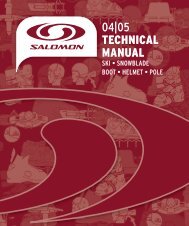SPM 05 ENvFIN.indd - Salomon Certification
SPM 05 ENvFIN.indd - Salomon Certification
SPM 05 ENvFIN.indd - Salomon Certification
Create successful ePaper yourself
Turn your PDF publications into a flip-book with our unique Google optimized e-Paper software.
FINAL CHECKING<br />
TROUBLESHOOTING<br />
Boot/Binding systems wear with time. This is expected. Normal wear and/or<br />
fatigue of a system can be expected. If a system inspection indicates a system<br />
is not functioning as intended, the cause of the problem must be identified and<br />
corrective action should be taken.<br />
The first step is to re-examine each component of the<br />
ski/binding/boot system individually. If a problem is found,<br />
e.g., stripped toe height screw, out-of-standard boot sole,<br />
improperly mounted binding, missing AFD, etc., proper<br />
Binding-to-Boot Adjustments cannot be made. No further<br />
work can be performed on the system. Mark “Fail” (√) on<br />
this section of the Workshop Form.* If the system failed the<br />
Test for Elastic Travel & Return, check that all boot/binding<br />
interfaces are clean, smooth and clear of debris. If the boot<br />
is dirty, clean it with a solution of mild dish washing soap<br />
and water. If the binding is dirty, clean it according to the<br />
procedures described in Maintenance and Repair. Check<br />
that the boot enters the binding correctly. Make sure the<br />
boot is properly positioned in the toe and heel cups. Check<br />
the visual indicator settings. They should not exceed the<br />
minimum or maximum setting and should be set appropriately<br />
for the skier. Re-test the system for Elastic Travel<br />
& Return. If the system fails this test, mark "Fail" (√) on<br />
this section of the Workshop Form.*<br />
If the system failed the Test for Boot/Binding Compatibility,<br />
recheck the system to make sure all components are<br />
compatible. If no problem is detected, perform a Clean vs.<br />
Lubricated Test. To perform a Clean vs. Lubricated Test,<br />
all adjustments to the system, e.g., visual indicator settings,<br />
forward pressure adjustments, etc., must be the same as<br />
when the system was previously tested. Lubricate the boot<br />
with a mild dish washing soap wherever it contacts the<br />
binding and wipe off any excess lubricant. Perform the twist<br />
and forward lean tests as done previously and record your<br />
results. Next, compare the results of the lubricated test<br />
with those of the previously performed non-lubricated clean<br />
test. Plot the results on the Compatibility Tables. If the<br />
results don’t fall within the shaded “Pass” window on the<br />
table, the BOOT is incompatible with the binding and should<br />
not be used. Mark “Fail” (√) on the Workshop Form.*<br />
If no problems have been found with the system and the<br />
Release Value Within Specified Range cannot be obtained,<br />
further tests must be undertaken. First, switch testers to<br />
check operator accuracy. Next, check the accuracy of the<br />
testing device per the device manufacturer’s recommendations.<br />
Re-test the system. If the system releases outside<br />
the “In-Use Range,” mark “Fail” (√) on this section of the<br />
Workshop Form.*<br />
If the customer refuses to have work done that is necessary<br />
to bring the system within standards, or requests work<br />
that violates the recommendations of this manual, the<br />
technician should check the box next to the statement<br />
indicating out-of-standard components on the Workshop<br />
Form. A note should be made in the Comment section of the<br />
form describing the problem and the skier should be warned<br />
that continued use of the system is inadvisable. The shop<br />
will not be indemnified for work done on that system.<br />
* The customer should be informed of, and authorize, action needed to correct the problem. Please refer to the Technical<br />
Reference section for warranty information on binding components covered under warranty.<br />
Twist Test Forward Lean Test<br />
100<br />
400<br />
Lubricated Test<br />
Compatibility Tables: Clean vs. Lubricated Tests<br />
Twist (Nm)<br />
90<br />
80<br />
70<br />
60<br />
50<br />
40<br />
30<br />
20<br />
10<br />
Fail<br />
Pass<br />
Fail<br />
0<br />
0 10 20 30 40 50 60 70 80 90 100<br />
Twist (Nm)<br />
Clean Test<br />
Lubricated Test<br />
Forward Lean (Nm)<br />
360<br />
320<br />
280<br />
240<br />
200<br />
160<br />
120<br />
80<br />
40<br />
Fail<br />
Pass<br />
Fail<br />
0<br />
0 40 80 120 160 200 240 280 320 360 400<br />
Forward Lean (Nm)<br />
Clean Test<br />
> Reference<br />
<strong>Salomon</strong> Retail Binding<br />
Limited Warranty<br />
<strong>Salomon</strong><br />
Workshop Form<br />
Test for Elastic<br />
Travel & Return<br />
Test for Boot/Binding<br />
Compatibility<br />
29<br />
57<br />
32<br />
27<br />
27








